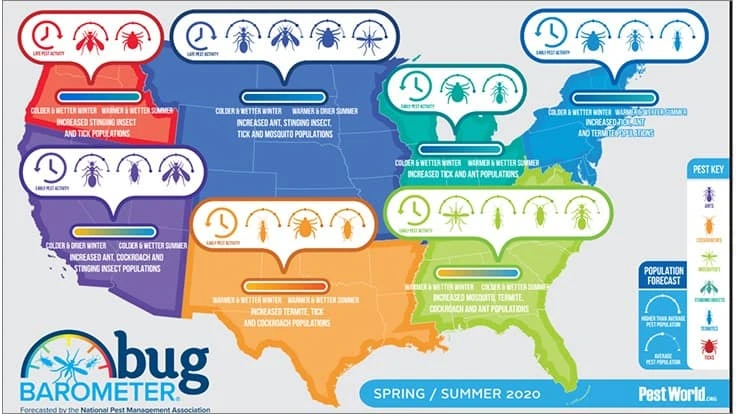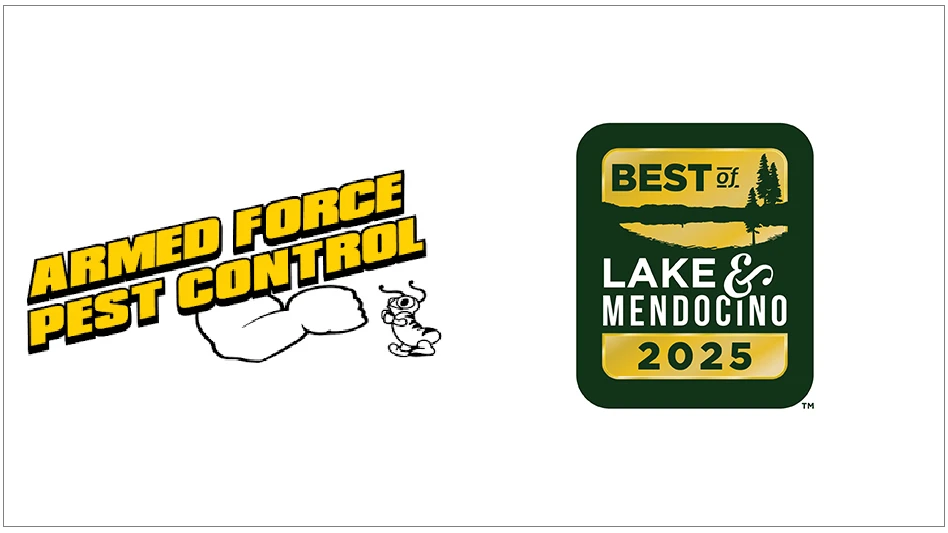
FAIRFAX, Va. - As temperatures and precipitation levels increase, so too do pest populations. Despite this unwelcomed fact, especially in the midst of collective concerns around the growing COVID-19 pandemic here in the U.S., the National Pest Management Association (NPMA) remains steadfast in its mission to protect public health from the threats posed by pests. The organization today released its bi-annual Bug Barometer®, a seasonal projection of the pest pressure Americans can expect to see in their respective regions. This information is designed to encourage proper pest prevention and protection measures to reduce pest encounters that can pose a risk to both health and home.
“It goes without saying that this is a sensitive and uncertain time not only across our country, but across the globe,” said Cindy Mannes, vice president of public affairs at NPMA. “With people spending more time in their homes and yards, they may be surprised at how much pest activity they begin to notice. Unfortunately, pest pressure and populations won’t slow down this time of year and it’s important to stay vigilant against insects and rodents, which can contaminate food, inflict harmful bites and stings, transmit disease and damage property.”
According to the group’s team of entomologists, ongoing warm, wet weather has allowed pest populations to spike early and will enable them to thrive throughout spring and summer across most of the U.S.
“Coast to coast, our country experienced unseasonably warm and wet conditions this winter, allowing certain pest populations not usually seen during this time of year to surge in population,” said Jim Fredericks, Ph.D., chief entomologist for the NPMA. “These conditions allowed vector pests such as ticks, responsible for the spread of Lyme disease, and mosquitoes, common vectors of West Nile virus, Zika virus and Eastern equine encephalitis to get a jumpstart on activity, and with more warm and wet weather predicted for summer across most of the U.S., we’ll likely see these populations, and others, rapidly expand.”
Homeowners should also be prepared for increased pressure from structural pests as well. “Damp conditions predicted for the Northeast, Southeast and South Central regions this spring and summer will enable termite, cockroach and ant populations to take hold and thrive. In areas expecting less moisture this season, stinging insects will also pose a significant threat, as families will be spending more time outdoors, increasing their likelihood of exposure to these dangerous pests, which send over 500,000 people to the emergency room every year,” added Fredericks.
Based on this analysis, the National Pest Management Association’s Spring/Summer Bug Barometer is forecasting a spike in moisture-loving pest populations across most of the U.S. this season:
Northeast & New England
A warm, dry spring followed by a warm and wet summer will contribute to an increase in tick activity. Damp conditions throughout the summer will also provide ideal conditions for ants, specifically carpenter ants, and termites to thrive.
Southeast
A mild and rainy spring will create conducive conditions that allow mosquito and termite populations to thrive. Summer conditions in southern Florida may also cause a spike in cockroach and ant pressure.
Great Lakes, Ohio Valley & Midwest
Warm and wet conditions throughout spring and summer across the entire region will contribute to an increase in tick pressure, and may result in greater ant populations.
North Central U.S.
Warm, dry summer conditions in the south will help ant populations thrive, and could mean more exposure to stinging insects. While cool conditions in the north may delay in tick activity, increased precipitation will create ideal conditions for mosquito populations to grow.
South Central U.S.
A warm spring followed by a warm and wet summer across the entire region is expected to result in an increase in pest pressure, specifically for termites, ticks and cockroaches.
Southwest U.S.
Cooler, wetter conditions throughout spring and summer are expected to drive ants indoors. Expect an increase in cockroach and stinging insect populations throughout the region.
Northwest U.S.
Humid conditions throughout spring and summer in the eastern part of this region will allow stinging insect and tick populations to flourish. Warm and wet conditions in the western part of this region may also contribute to increased mosquito populations.
Latest from Pest Control Technology
- Fleetio Announces New Hires, Partnerships and Products
- Target Specialty Products, BASF to Present 'Best Pesticide Formulation for the Job' Webinar
- Abell Pest Control Holds Snap Trap Challenge
- Massey Services’ Davis Earns ACE Certification
- Upcoming Webinar: Distribution, Status, and Management of Native and Invasive Termites
- Knox Pest Control Announces Acquisition
- Veseris Expands in Canada with New Montreal ProCenter and Warehouse
- Clark's QA Manager on Opportunities Given to Sustain a Lifelong Career in Pest Control





